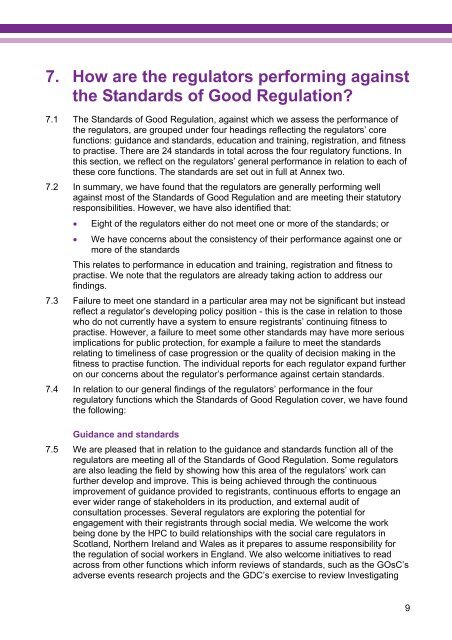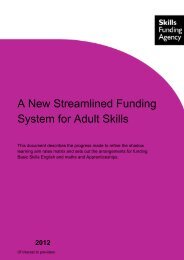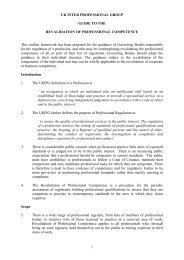CHRE Performance review report 2011-12 - Professional Standards ...
CHRE Performance review report 2011-12 - Professional Standards ...
CHRE Performance review report 2011-12 - Professional Standards ...
Create successful ePaper yourself
Turn your PDF publications into a flip-book with our unique Google optimized e-Paper software.
7. How are the regulators performing against<br />
the <strong>Standards</strong> of Good Regulation?<br />
7.1 The <strong>Standards</strong> of Good Regulation, against which we assess the performance of<br />
the regulators, are grouped under four headings reflecting the regulators’ core<br />
functions: guidance and standards, education and training, registration, and fitness<br />
to practise. There are 24 standards in total across the four regulatory functions. In<br />
this section, we reflect on the regulators’ general performance in relation to each of<br />
these core functions. The standards are set out in full at Annex two.<br />
7.2 In summary, we have found that the regulators are generally performing well<br />
against most of the <strong>Standards</strong> of Good Regulation and are meeting their statutory<br />
responsibilities. However, we have also identified that:<br />
Eight of the regulators either do not meet one or more of the standards; or<br />
We have concerns about the consistency of their performance against one or<br />
more of the standards<br />
This relates to performance in education and training, registration and fitness to<br />
practise. We note that the regulators are already taking action to address our<br />
findings.<br />
7.3 Failure to meet one standard in a particular area may not be significant but instead<br />
reflect a regulator’s developing policy position - this is the case in relation to those<br />
who do not currently have a system to ensure registrants’ continuing fitness to<br />
practise. However, a failure to meet some other standards may have more serious<br />
implications for public protection, for example a failure to meet the standards<br />
relating to timeliness of case progression or the quality of decision making in the<br />
fitness to practise function. The individual <strong>report</strong>s for each regulator expand further<br />
on our concerns about the regulator’s performance against certain standards.<br />
7.4 In relation to our general findings of the regulators’ performance in the four<br />
regulatory functions which the <strong>Standards</strong> of Good Regulation cover, we have found<br />
the following:<br />
Guidance and standards<br />
7.5 We are pleased that in relation to the guidance and standards function all of the<br />
regulators are meeting all of the <strong>Standards</strong> of Good Regulation. Some regulators<br />
are also leading the field by showing how this area of the regulators’ work can<br />
further develop and improve. This is being achieved through the continuous<br />
improvement of guidance provided to registrants, continuous efforts to engage an<br />
ever wider range of stakeholders in its production, and external audit of<br />
consultation processes. Several regulators are exploring the potential for<br />
engagement with their registrants through social media. We welcome the work<br />
being done by the HPC to build relationships with the social care regulators in<br />
Scotland, Northern Ireland and Wales as it prepares to assume responsibility for<br />
the regulation of social workers in England. We also welcome initiatives to read<br />
across from other functions which inform <strong>review</strong>s of standards, such as the GOsC’s<br />
adverse events research projects and the GDC’s exercise to <strong>review</strong> Investigating<br />
9










